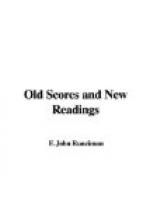this is our gain, even if the gain is not great.
The Representation of Chaos is a curious bit of music,
less like chaos than an attempt to write music of
the Bruneau sort a century too soon; but it serves.
The most magnificent passage in the oratorio immediately
follows, for there is hardly a finer effect in music
than that of the soft voices singing the words, “And
the Spirit of God moved upon the face of the waters,”
while the strings gently pulse; and the fortissimo
C major chord on the word “light,” coming
abruptly after the piano and mezzo-forte minor chords,
is as dazzling in its brilliancy to-day as when it
was first sung. The number of unisons, throwing
into relief the two minor chords on C and F, should
be especially noted. The chorus in the next number
is poor, matched with this, though towards the end
(see bars 11 and 12 from the finish) Haydn’s
splendid musicianship has enabled him to redeem the
trivial commonplace with an unexpected and powerful
harmonic progression. The work is singularly deficient
in strong sustained choruses. “Awake the
harp” is certainly very much the best; for “The
heavens are telling” is little better than Gounod’s
“Unfold, ye everlasting portals” until
the end, where it is saved by the tremendous climax;
and “Achieved is the glorious work” is
mostly mechanical, with occasional moments of life.
As for the finale, it is of course light opera.
On the whole the songs are the most delightful feature
of the “Creation,” and the freshness of
“With verdure clad,” and the tender charm
of the second section of “Roaming in foaming
billows,” may possibly be remembered when Haydn
is scarcely known except as an instrumental composer.
The setting of “Softly purling, glides on, thro’
silent vales, the limpid brook” is indeed perfect,
the phrase at the repetition of “Thro’
silent vales” inevitably calling up a vision,
not of a valley sleeping in the sunlight, for of sunlight
the eighteenth century apparently took little heed,
but of a valley in the dark quiet night, filled with
the scent of flowers, and the far-off murmur of the
brook vaguely heard. The humour of the oratorio
consists chiefly of practical jokes, such as sending
Mr. Andrew Black (or some other bass singer) down
to the low F sharp and G to depict the heavy beasts
treading the ground, or making the orchestra imitate
the bellow of the said heavy beasts, or depicting
the sinuous motion of the worm or the graceful gamboling
of the leviathan. It has been objected that the
leviathan is brought on in sections. The truth,
of course, is that the clumsy figure in the bass is
not meant to depict the leviathan himself, but his
gambolings and the gay flourishings of his tail.
It is hard to sum up the “Creation,” unless
one is prepared to call it great and never go to hear
it. It is not a sublime oratorio, nor yet a frankly
comic oratorio, nor entirely a dull oratorio.
After considering the songs, the recitatives, the
choruses, in detail, it really seems to contain very
little. Perhaps it may be described as a third-rate
oratorio, whose interest is largely historic and literary.




